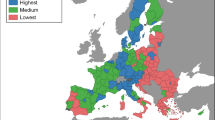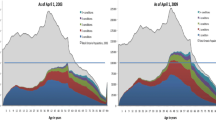Abstract
In a context of increasing ageing of the population, it is crucial to better understand multimorbidity and its consequences. This study measured the prevalence of multimorbidity in a Southern Europe population and projected its evolution based on expected demographic changes. It also analysed its associated consequences on self-reported health status, functional capacity, and healthcare use. Our sample included all people aged 25–79 years (6679 men and 8517 women) who participated in the fifth Portuguese National Health Interview Survey, conducted in 2014. Multimorbidity was measured by the presence of at least two self-reported chronic conditions. Multivariable regressions were used to assess the association of multimorbidity with health status, functional capacity, and healthcare use. The projected evolution of multimorbidity was based on official demographic projections. 43.9% of the Portuguese population self-reported the multimorbidity, which was more frequent among older people, women, and low-educated people. We found an association of multimorbidity with poorer health status (OR 3.32, 95%CI 2.60–4.24) and with limited functional capacity (OR 4.44, 95%CI 3.85–5.11). Multimorbidity was also associated with higher healthcare resource use, namely a 26% increased likelihood of hospitalization in the previous 12 months per additional comorbidity. We projected a 13.1% growth in the prevalence of multimorbidity until the year 2050. Multimorbidity affects a substantial share of the population and is expected to grow in the near future related to population ageing. The co-occurrence of chronic health conditions increases sharply with age and is associated with worse health status, reduced functional capacity, and increased healthcare use.



Similar content being viewed by others
References
Anderson G (2010) Chronic care: making the case for ongoing care. http://www.rwjf.org/en/researchpublications/find-rwjf-research/2010/02/chronic-care.html. Accessed Nov 2017
Barnett K, Mercer SW, Norbury M, Watt G, Wyke S, Guthrie B (2012) Epidemiology of multimorbidity and implications for health care, research, and medical education: a cross-sectional study. Lancet 380(9836):37–43
Bertakis KD, Azari R, Helms LJ, Callahan EJ, Robbins JA (2000) Gender differences in the utilization of health care services. J Fam Pract 49:147–152
Boerma T, Hosseinpoor AR, Verdes E, Chatterji S (2016) A global assessment of the gender gap in self-reported health with survey data from 59 countries. BMC Public Health 30(16):675
Charles M (2011) A world of difference: international trends in women’s economic status. Annu Rev Sociol 37:355–371
Cleary PD, Mechanic D, Greenley JR (1982) Sex differences in medical care utilization: an empirical investigation. J Health Soc Behav 23:106–119
DeSalvo KB, Fan VS, McDonell MB, Fihn SD (2005) Predicting mortality and healthcare utilization with a single question. Health Serv Res 40(4):1234–1246
Diederichs C, Berger K, Bartels D (2011) The measurement of multiple chronic diseases—a systematic review on existing multimorbidity indices. J Gerontol A Biol Sci Med Sci 66:301–311
European Commission (2015) DG ECFIN, The 2015 ageing report, economic and budgetary projections for the 28 EU member states (2013–2060). In: European economy 3/2015. http://ec.europa.eu/economy_finance/publications/european_economy/2015/pdf/ee3_en.pdf. Accessed Nov 2017
EUROSTAT. http://ec.europa.eu/eurostat/. Accessed Nov 2017
Fann JR, Ell K, Sharpe M (2012) Integrating psychosocial care into cancer services. J Clin Oncol 30(11):1178–1186
Feinstein L, Sabates R, Anderson TM, Sorhaindo A, Hammond C (2006) What are the effects of education on health? In measuring the effects of education on health and civic engagement. In: Proceedings of the Copenhagen symposium. OECD, pp 117–354
Ferraro KF, Su Y (2000) Physician-evaluated and self-reported morbidity for predicting disability. Am J Public Health 90(1):103
Formiga F, Ferrer A, Sanz H, Marengoni A, Alburquerque J, Pujol RM (2013) Patterns of comorbidity and multimorbidity in the oldest old: the Octabaix study. Eur J Intern Med 24:40–44
Fortin M, Lapointe L, Hudon C, Vanasse A, Ntetu A, Maltais D (2004) Multimorbidity and quality of life in primary care: a systematic review. Health Qual Life Outcomes 2:51
Gijsen R, Hoeymans N, Schellevis F, Ruwaard D, Satariano W, Bos G (2001) Causes and consequences of comorbidity: a review. J Clin Epidemiol 54:661–674
Gortmaker SL, Swinburn BA, Levy D, Carter R, Mabry PL, Finegood DT, Huang T, Marsh T, Moodie ML (2011) Changing the future of obesity: science, policy, and action. Lancet 378(9793):838–847
Idler EL, Benyamini Y (1997) Self-rated health and mortality: a review of twenty-seven community studies. J Health Soc Behav 38:21–37
INE. https://www.ine.pt. Accessed Nov 2017
Instituto Nacional de Estatística - Resident Population Projections. https://www.ine.pt and file:///C:/Users/pedro.laires/Downloads/28ProjPopresidPort2012_2060ingles.pdf. Accessed Nov 2017
Instituto Nacional de Estatística. Inquerito Nacional de Saúde 2014. INE. Lisboa: INE; 2016. 310 p
Jagger C, Gillies C, Cambois E, Al E (2010) The Global Activity Limitation Index measured function and disability similarly across European countries. J Clin Epidemiol 63:892–899
Kadam U, Croft P, North Staffordshire GP Consortium Group (2007) Clinical multimorbidity and physical function in older adults: a record and health status linkage study in general practice. Fam Pract 24:412–419
Kaplan GA, Haan MN, Cohen RD (1992) Risk factors and the study of prevention in the elderly: methodological issues. In: Wallace RB, Woolson RF (eds) Epidemiologic study of the elderly. Oxford University Press, New York, pp 20–36
Kawada T (2003) Self-rated health and life prognosis. Arch Med Res 34:343–347
Miilunpalo S, Vuori I, Oja P, Pasanen M, Urponen H (1997) Self-rated health status as a health measure: the predictive value of self-reported health status on the use of physician services and on mortality in the working-age population. J Clin Epidemiol 50(5):517–528
Mortality Data (2013) World Health Organization, Geneva. http://www.who.int/gho/mortality_burden_disease/life_tables/en/index.html. Accessed Nov 2017
Mossey JM, Shapiro E (1982) Self-rated health: a predictor of mortality among the elderly. Am J Public Health 72:800–808
Nagel G, Peter R, Braig S, Hermann S, Rohrmann S, Linseisen J (2008a) The impact of education on risk factors and the occurrence of multimorbidity in the EPIC-Heidelberg cohort. BMC Public Health 8:384
Nagel G, Peter R, Braig S, Hermann S, Rohrmann S, Linseisen J (2008b) The impact of education on risk factors and the occurrence of multimorbidity in the EPIC-Heidelberg cohort. BMC Public Health 11(8):384. https://doi.org/10.1186/1471-2458-8-384
Navickas R, Petric V-K, Feigl AB, Seychell M (2016) Multimorbidity: what do we know? What should we do? J Comorbidity 6(1):4–11
Nuño R, Coleman K, Bengoa R, Sauto R (2012) Integrated care for chronic conditions: the contribution of the ICCC Framework. Health Policy 105(1):55–64
Ornstein SM, Nietert PJ, Jenkins RG, Litvin CB (2013) The prevalence of chronic diseases and multimorbidity in primary care practice: a PPRNet report. J Am Board Fam Med 26(5):518–524
Oyen H, Van der Heyden J, Perenboom R, Jagger C (2006) Monitoring population disability: evaluation of a new Global Activity Limitation Indicator (GALI). Soz Praventivmed 51:153–161
Perelman J, Fernandes A, Mateus C (2012) Gender disparities in health and healthcare: results from the Portuguese National Health Interview Survey. Cad Saude Publica 28(12):2339–2348
Ramond-Roquin A, Fortin M (2016) Towards increased visibility of multimorbidity research. J Comorbidity 6(2):42–45
Richardson E, Van Ginneken E, Richardson E, Figueras J, Kluge H, Lessof S, McDaid D, Mossialos E, Permanand G, North J, White C (2017) How to improve care for people with multimorbidity in Europe? Copenhagen (Denmark): European Observatory on Health Systems and Policies. European Observatory Policy Briefs
Rijken PM, Bekkema N (2011) Chronic disease management matrix 2010. Results of a survey in ten European countries. NIVEL, Utrecht
Robine JM, Jagger C, Euro-REVES Group (2003) Creating a coherent set of indicators to monitor health across Europe: the Euro-REVES 2 project. Eur J Public Health 13:6–14
Salisbury C, Johnson C, Purdy S, Valderas JM, Montgomery A (2011) Epidemiology and impact of multimorbidity in primary care: a retrospective cohort study. Br J Gen Pract 582:e12–e21
Statistics Portugal: methodological details of the National Health Survey, including sampling weights. https://www.ine.pt/xportal/xmain?xpid=INE&xpgid=ine_publicacoes&PUBLICACOESpub_boui=263714091&PUBLICACOESmodo=2&xlang=en. Accessed Nov 2017
Sundquist J, Johansson SE (1997) Self reported poor health and low educational level predictors for mortality: a population based follow up study of 39,156 people in Sweden. J Epidemiol Community Health 51:35–40
Tackling obesities: future choices—project report. 2007 Oct 17. http://www.foresight.gov.uk/Obesity/Obesity_final/Index.html
Treadwell J (2015) Coping with complexity: working beyond the guidelines for patients with multimorbidities. J Comorbidity 5(1):11–14
Valderas JM, Starfield B, Roland M (2007) Multimorbidity’s many challenges: a research priority in the UK. BMJ 334(7604):1128
Van den Akker M, Buntix F, Knottnerus JA (1996) Comorbidity or multimorbidity: what’s in a name? A review of literature. Eur J Gen Pract 2:65–70
van den Akker M, Buntinx F, Metsemakers JFM, Roos S, Knottnerus JA (1998) Multimorbidity in general practice: prevalence, incidence, and determinants of co-occurring chronic and recurrent diseases. J Clin Epidemiol 51:367–375
Verbrugge LM (1982) Sex differentials in health. Public Health Rep 97:417–437
Violan C, Foguet-Boreu Q, Flores-Mateo G, Salisbury C, Blom J, Freitag M, Glynn L, Muth C, Valderas JM (2014a) Prevalence, determinants and patterns of multimorbidity in primary care: a systematic review of observational studies. PLoS ONE 9(7):e102149
Violan C, Foguet-Boreu Q, Flores-Mateo G, Salisbury C, Blom J, Freitag M, Glynn L, Muth C, Valderas JM (2014b) Prevalence, determinants and patterns of multimorbidity in primary care: a systematic review of observational studies. PLoS ONE 9:e102149
Walker A (2007) Multiple chronic diseases and quality of life: patterns emerging from a large national sample, Australia. Chronic Illn 3:202–218
WHO (2011) Global status report on noncommunicable diseases 2010: description of the global burden of NCDs, their risk factors and determinants. World Health Organization, Geneva. http://www.who.int/nmh/publications/ncd_report2010/en/. Accessed Nov 2017
Wolff J, Starfield B, Anderson G (2002) Prevalence, expenditures, and complications of multiple chronic conditions in the elderly. Arch Intern Med 162:2269–2276
Author information
Authors and Affiliations
Corresponding author
Ethics declarations
Conflict of interest
Pedro Laires is a Novartis employee. The current project was, however, developed during his postdoctoral internship at Nova University and was totally unrelated to any Novartis product or Grant.
Additional information
Responsible editor: Matthias Kliegel.
Appendices
Appendix 1
See Table 2.
Appendix 2
Appendix 3: Absolute numbers and percentage of sample and due projected population’s distribution according to number of chronic health conditions
NR disorders | Sample | Population | Percentage (%) |
|---|---|---|---|
0 | 5441 | 2,764,162 | 35.8 |
1 | 2568 | 1,269,005 | 16.9 |
2 | 1985 | 947,338 | 13.1 |
3 | 1625 | 733,925 | 10.7 |
4 | 1326 | 549,397 | 8.7 |
5 | 931 | 402,049 | 6.1 |
6 | 652 | 270,974 | 4.3 |
7 | 350 | 129,241 | 2.3 |
8 | 188 | 76,082 | 1.2 |
9 | 80 | 24,235 | 0.5 |
> = 10 | 50 | 17,118 | 0.3 |
Total | 15,196 | 7183,526 |
Rights and permissions
About this article
Cite this article
Laires, P.A., Perelman, J. The current and projected burden of multimorbidity: a cross-sectional study in a Southern Europe population. Eur J Ageing 16, 181–192 (2019). https://doi.org/10.1007/s10433-018-0485-0
Published:
Issue Date:
DOI: https://doi.org/10.1007/s10433-018-0485-0




